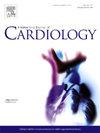Angiography-derived index of microcirculatory resistance as a novel tool to assess coronary microvascular dysfunction in patients with diabetic cardiomyopathy
IF 3.2
2区 医学
Q2 CARDIAC & CARDIOVASCULAR SYSTEMS
引用次数: 0
Abstract
Backgrounds
Coronary microvascular dysfunction (CMD) has been proposed as a major mechanism and a potential therapeutic target for diabetic cardiomyopathy (DbCM); however, it has not been fully investigated in a clinical setting. The angiography-derived index of microcirculatory resistance (AMR) is a novel non-invasive measurement of CMD that exhibits promising clinical applications.
Methods
AMR was measured in hospitalized patients with DbCM and in control patients. The incidence, clinical characteristics, risk factors, and effects of pharmacological interventions on CMD were investigated.
Results
AMR was significantly higher in patients who met the DbCM-2B diagnostic criteria. The independent risk factors for abnormal AMR included diabetes, body mass index (BMI), and N-terminal pro-brain natriuretic peptide (NT-pro-BNP). Patients with elevated NT-pro-BNP had high AMR, and those grouped by medication indicated that ACEI/ARB, sacubitril/valsartan, and trimetazidine might lower AMR in patients with elevated NT-pro-BNP.
Conclusions
The DbCM-2B diagnostic criteria demonstrated a strong correlation with CMD. ACEI/ARB, sacubitril/valsartan, and trimetazidine might improve CMD in patients with DbCM.
求助全文
约1分钟内获得全文
求助全文
来源期刊

International journal of cardiology
医学-心血管系统
CiteScore
6.80
自引率
5.70%
发文量
758
审稿时长
44 days
期刊介绍:
The International Journal of Cardiology is devoted to cardiology in the broadest sense. Both basic research and clinical papers can be submitted. The journal serves the interest of both practicing clinicians and researchers.
In addition to original papers, we are launching a range of new manuscript types, including Consensus and Position Papers, Systematic Reviews, Meta-analyses, and Short communications. Case reports are no longer acceptable. Controversial techniques, issues on health policy and social medicine are discussed and serve as useful tools for encouraging debate.
 求助内容:
求助内容: 应助结果提醒方式:
应助结果提醒方式:


